German amphibious vehicles
Presumably, this “car boat” (in other words, Mobile-bot) was the length of the 7,2 meter and the width of the 1,8 meter. Total weight - 2 tons. 28,0 engine horsepower (20,6 kW). The maximum water speed was 6,5 kilometers per hour and was provided with two propellers (diameter 320 mm). The conditional energy loading of the screws was equal to 128,2 kW / m2.
When the power density of the vessel 10,3 kW / t, the relative speed on the water was 0,51. The total stop of the propellers, relative to the hydraulic area of the propellers, was approximately 23,57 kN / m2.
There is no more information about this “motor boat”, except that it was forgotten after the next and most likely very strong jam in the coastal zone of the North Sea.
Despite this, its appearance led to the creation of another wheeled amphibious "Goppe-Cross", which was created to equip the customs service. The wheel formula of the amphibious vehicle was 4x4, the total weight of the 4 ton, the engine power was 45 hp. (33,12 kW), it was arranged in the middle of the boat. Power was taken from the two ends of the crankshaft: from the front end to the propeller shaft through the vertical gearbox, shaft and coupling, and from the rear through the clutch, vertical transfer case, shafts and gearbox to the main drive axles.
It should be noted that the selection of power from a pair of crankshaft ends, although it complicated the design of the amphibian, was rational for several reasons, the main of which was that with such a scheme, the drive of the propulsion propulsion was independent, that is, it was not associated with gears in the gearbox.
The overall dimensions of this machine were: length - 6800 mm, width - 2100 mm, wheelbase - 3170 mm, front track - 2300 mm, track on the outer wheel of rear dual wheels - 2450 mm.
The water speed was 11 kilometers per hour and was provided with one propeller with a diameter of 450 mm. The power density of the amphibian was 8,28 kW / t. Three of this Froude number in displacement was equal to 0,77. Conventional energy loading of the propeller - 208,4 kW / m2. The stop of the propeller, relative to the hydraulic area of the screw, was approximately 34,81 kN / m2.
There is no information about how many of these machines were produced and how they were used. But both amphibious vehicles show that at the dawn of amphibious construction in Germany, an attempt was made to give a motorboat land properties due to automobile bridges and power from the boat engine to them.
In subsequent years, motorization in Germany advanced quite strongly, however, in the years before the First World War, and during the war years, practically no work was done on creating such machines.
Only in 1932, Hans Triple 24-year-old design engineer on his own initiative, began to create an amphibious vehicle. However, he did not follow the path of his predecessors, who adapted the motorboats for movement on land, but, on the contrary, at first began to change the design of cars to provide them with water flow properties. Triple modified DKW chassis design with two-cylinder two-cylinder engine and drive to the front axle. He installed a propeller in the back of the machine, which was driven through an auxiliary drive from the gearbox.
The first successes allowed Triple to create a second amphibious vehicle already in 1933. As the chassis was used passenger car "Triumph" Adler. This sample also had a front-wheel drive, but a more powerful four-stroke 4 cylinder engine was used. The drive and propeller layout was similar to the first model. About these machines it became known in the Wehrmacht and in 1934, G. Trippel was given the first military order to create an experimental amphibious vehicle.
The basic model for the small-capacity amphibious vehicle for the Wehrmacht has become the standard lightweight car with all steering and driving wheels. To install machine gun weapons in front of the machine, its engine, systems, clutch and gearbox were moved to the middle part. Aft propeller mounted and gearbox drive. However, as further tests showed, such a change in the layout scheme was not entirely successful.
To continue the work on creating amphibious machines, G. Triplel bought a small factory in Saar, where SG 1935 was created in 6 in the year.
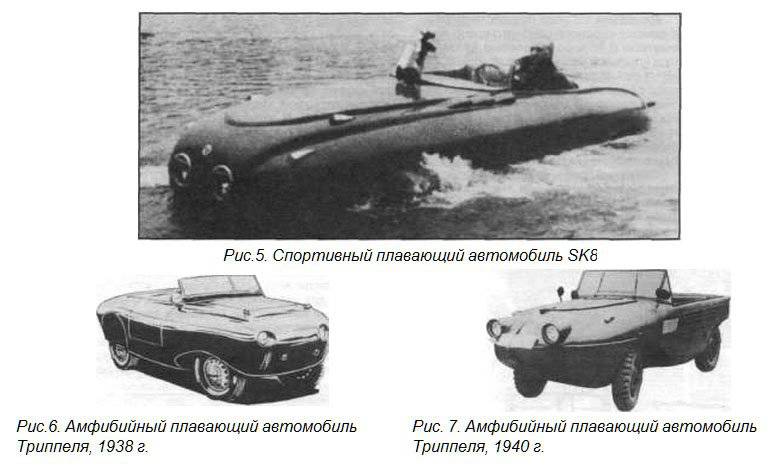
The SG 6 had a bearing metal displacement hull. The wheel formula is 4x4. Initially, 6's Adler cylinder engine and later Opel's 4 cylinder engine were installed on SG 6. The manual transmission had limited slip differentials that increase the vehicle’s permeability. The stern propeller was removed from the driver's seat into the hull's niche when the machine entered the land. This model was produced up to 1944 year inclusive. At the same time, the total number of cars did not exceed 1000 units. Naturally, according to the results of combat operation, changes were made annually in the design of the car, but it is rather difficult to track them.
In one of the variants of the car, the engine and its systems were assembled in the front part of the body, which had a spoon-like shape, which made it possible to reduce water resistance. In the middle part were installed seats for the driver and four passengers and controls. In the rear part there was a fuel tank with a volume of 60 liters and a niche into which the propeller was removed (three blades, diameter 380 mm) while on land. The drive of the propeller from the power take-off, which was installed on the gearbox, was displaced millimeters 140 to the left side of the machine's longitudinal axis. With the vertical position of the column of the drive chain of the propeller, this led to the creation of a turning moment that deflected the car to the right side while driving through the water. The shift of the car to the right was eliminated either by turning the front steer wheels to the left, or by turning the screw column until the axle was aligned with the longitudinal axis of the car. However, in both cases, the elimination of the deviation led to a decrease in speed on the water.
When the propeller drive columns were positioned vertically, almost the entire hydraulic area of the screw was below the plane of the bottom of the car and they were not shielded. This ensured the leakage of water to the propeller, however, increased the likelihood of damage during movement in shallow water, out of the water to the shore and the entrance to it. In this regard, a protective crutch was installed on the bottom of the crankcase of the column, which protected the screw from breakage in case of contact with underwater obstacles, and did not result in its cleaning into the housing niche. Therefore, if the conditions on the coast were not known, the exit from the water and the entrance to it were made with the screw removed due to the thrust of the driving wheels of the car. The screw was lowered into the working position only after the car completely emerged. However, in many cases this did not provide for overcoming the coastal strip.
With a power of 40,48 kW of a car engine, the conventional energy load of the screw was 357,28 kW / m2, which ensured movement in calm deep water at speeds up to 12 km / h. The relative velocity at the same time (Froude number in displacement) was equal to 0,92. Driving while driving on water was provided by changing the position of the front steering wheels. This method of rotation guaranteed good handling while driving at sufficiently high or maximum speeds. When driving at low speeds, the machine’s handling was inadequate, especially on a river with a noticeable flow rate.
Wheel suspension - independent with swing arms in the transverse plane. Coil springs were elastic suspension elements. The maximum speed on the highway with a specific power 17,6 kW / t was equal to 105 kilometers per hour.
Mass-overall parameters: gross weight - 2,3 tons, lifting capacity - 0,8 tons, length - 4,93 m, width - 1,86 m, wheelbase - 2,430 m, track - 1,35 m, ground clearance - 30 see.
In 1937, the sports plant SK 8 was developed at the Saar plant. This car was less heavy, had a more streamlined body, was equipped with Adler's 2-liter engine, the front wheels were driven. The propeller was fixedly mounted in the aft housing niche. The car was tested for two years on the rivers of Germany as well as in the Mediterranean and North Sea. This development again attracted the attention of the Wehrmacht.
At G. Tripple's factory in 1938, a new model of an amphibious vehicle was developed and manufactured. The main changes in this model concerned the car body. The car received more streamlined shapes; removable covers covered the rear wheel niches; there were two doors of rather large sizes and some other innovations of which were not available in previous models of German amphibious vehicles.
Mr. Triplel in 1939 received the order from the Wehrmacht to create an amphibious vehicle for the sapper units on the basis of SG 6. She was supposed to have a wider, up to two meters, body and capable of transporting up to 16 people.
Here, in the story about amphibious vehicles of G. Trippel, it is necessary to take a short break, since in the 1939-1940 years the Wehrmacht decided to equip ground forces with various amphibious equipment that would be useful during the invasion of England.
Among the first works in this direction was the creation of a craft designed for lungs tanks, which made it possible to swim across wide water barriers, and after reaching land to dump auxiliary pontoons and equipment that provides buoyancy and speed. Further, the transport was supposed to act like a regular tank.
One such craft (Panzerkampfwagen II mit Schwimmkorper) was developed in Roslau by Sachsenberg at the end of 1940 of the year. It was intended for light tanks Pz Kpfw II Aust C. In the course of this work, two types of additional pontoons were tested: in one case, the pontoons were fixed along the sides (in this they significantly increased water resistance since the width of the watercraft with the tank was large); in the second case, the main pontoons were located behind and in front of the tank hull (in this case, the water resistance decreased, a higher speed was achieved while driving on water).
Light tanks Pz Kpfw II, which were produced in Germany from June 1938 ode seven companies (Henschel, Daimler-Benz, MAN and others), had a combat weight - 8900 kg, length - 4,81 m, width - 2,22 m and height - 1,99 m. The crew of the tvnka consisted of three people. The tanks had bulletproof booking with thick sheets of the tower and the 14,5 mm housing. The armament consisted of a 20 millimeter cannon and a 7,92 millimeter machine gun. They were installed in a tower of circular rotation. The Maybach engine with a power of 190 kW allowed ground speed to reach 40 kilometers per hour, by water (provided the tank was equipped with a floating craft) - 10 kilometers per hour. Water propellers were driven from the drive wheels of a tracked propulsor.
On the basis of two modifications of tracked radio-controlled vehicles for demining (Minenraumwagen), Borgward has developed an experimental floating machine for the same purpose. It was equipped with an 36 kW engine, had a 4-x roller track undercarriage and a three-bladed stern propeller with two water rudders installed on either side of it designed to control the machine afloat. Information about the use of this experimental radio-controlled amphibious machine no.
The Wehrmacht in the 1936 year ordered the Rheinmetall company to develop and manufacture a special tracked floating machine for landing operations - LWS (Land-Wasser-Schlepper). The new car was supposed to not only carry troops in the vehicle's hull, but also tow the floating wheeled trailers with different load capacities.
Initially it was assumed that the LWS will be used in European restricted areas, as well as during the invasion of England. However, after the refusal of the invasion, interest in floating vehicles in Germany has almost disappeared.
Initially, the LWS was a tracked tug that was designed to carry a 20 man in his hull (man’s crew 3). Gross vehicle weight from 16 to 17 tons. Armament on the LWS was not installed. The amphibious vehicle was equipped with a towing device and a winch. Dimensions LWS: length - 8600 mm, width - 3160 mm, height - 3130 mm.
The body of the machine was made of steel sheets, its nose was pointed, the bottom was smooth. Some sheets of the body, especially the nasal bottom sheet, were reinforced with stiffening ribs (stampings). The hull cabin was located in the middle and front parts of the hull. She was about a meter above the roof of the hull. In front of the cabin there was a department of management (three crew members), followed by a branch of the landing force. In the front there were closed windows with a large glass area, the side cuttings of the cabin had portholes.
206 kW carburetor V-shaped 12-cylinder engine Maybach HL 120 NRMV-12 (installed on pre-production machines) was placed in the rear part. The engine provided a maximum speed of up to 40 km / h on the highway, with power density - 12,87 kW / t. Cruising range for fuel - 240 kilometers. Tracked propulsion had rear guides and front drive wheels. The chassis had on each board 8 track rollers and 4 supporting. However, there was unsatisfactory maneuverability and mobility on land.
Movement on the water provided two tunnel four-bladed propellers diameter of 800 millimeters. Behind the screws installed water rudders. The maximum speed without the water load was 12,5 kilometers per hour. The Froude number in displacement (without load) was equal to 0,714. The conditional energy loading of the screws is 205,0 kW / m2. Water quality of the car was rated as good.
A floating tractor on land and afloat could tow a three- or four-axle wheeled floating trailer (with a lifting capacity of 10 and 20 tons, respectively). These trailers were intended for transportation of various military goods.
The body of the three-axle trailer is a pontoon with parallel vertical sides. Trailer length - 9000 mm, width - 3100 mm, height - 2700 mm. The dimensions of the loading platform: length - 8500 mm, width - 2500 mm. To facilitate loading and unloading, the trailer was equipped with a tailgate hinged on its hinges.
The overall dimensions of the four-axle floating trailer were: length - 10000 mm, width - 3150 mm, height - 3000 mm. The net weight of the trailer was 12,5 thousand kg. In order to increase the maneuverability while driving over rough terrain, tracked ribbons were put on wheels.
Probably, in addition to the seven pre-series amphibious vehicles, 14 vehicles of the second LWS series were also produced. The machines of the second series had some improvements in the design and partial booking of the hull, but practically the same technical characteristics as the pre-production cars. On machines of the second series, the carburetor engine Maybach HL 12 TRM was installed on a V-shaped 220-cylinder 120 kW.
Amphibious vehicles LWS used on the Eastern Front and also in North Africa. In particular, they participated in Europe during the storming of Tobruk.
In the middle of 1942, the Pz F armored tracked carrier (Panzerfahre) was created to replace unarmored LWS. The base was taken as a medium tank PzKpfw IV Aust F (chassis, engine, transmission units). It was made two prototypes. These tracked armored transporters were capable of towing heavy-duty wheeled amphibious trailers on water and over land.
Now back to the triple amphibious vehicles. After the end of hostilities in France, Triplet in June 1940 of the year acquired the Bugatti automobile plant in Alsace, where they also organized the production of amphibious vehicles. All wheels of this car were leading and controlled. The propulsion on the water served as a three-bladed motionless propeller mounted.
The main share of G.Trippel's products was advanced X-wheel drive SG 6, equipped with an ONE 2,5-liter 6-cylinder engine. Uniaxial floating trailers were also developed for these vehicles, which were towed by car and transported a variety of military cargoes by water.
All previous amphibious Triple cars had an open-top hull, but in 1942, a batch of cars with a fully enclosed hull and a sliding roof was made. These machines were equipped with propaganda units.
In the 43 year, a four-wheel-drive amphibious vehicle SG 7, with a V-shaped 8 cylinder air-cooled engine "Tatra", which was located in the rear part, was designed and built. The car was not serially produced, but became the basis for creating an E-3 reconnaissance floating wheeled vehicle armed with a machine gun and an 20-millimeter cannon. The amphibian hull reservation was differentiated, (thickness from 5,5 to 14,5 millimeters). The sheets had large angles of inclination. The total length of the armored car is 5180 mm, width -1900 mm. This car in 1943-1944 released in small batches. In October 1944, Triplel was notified of the discontinuation of the release of the floating wheeled vehicle E 3.
The wheel formula is Е 3 - 4х4. The Tatra engine, which had air cooling and 52 kW power, was located in the stern. The propellers on the water were two rowing tunnel screws. In 1944, a modification of the E 3, an amphibious armored wheeled vehicle E 3M, was created, designed to transport ammunition.
In addition, in 1944, floating snowmobiles were created, which, in addition to four wheels, had volumetric skids for sliding on snow and swimming. Aft was installed aviation large diameter propeller. With it, snowmobiles moved through snow and water. However, only three such cars were made.
Somewhat later, additional equipment was developed for SG 6, which significantly improved its maneuverability on soils with low bearing capacity. The appearance of this equipment was caused by frequent sticking of amphibious vehicles during entry into, out of the water as well as while driving in shallow water. In this case, the movement was provided only by the thrust of the drive wheels, which was significantly reduced due to the decrease in the coupling weight of the car. The decrease in the latter was due to the effects of hydrostatic maintenance forces (buoyancy) on the car.
At the end of World War II, it was forbidden to develop various military equipment in Germany, including amphibious vehicles. Despite this, Triple was able to slightly improve and modernize the design of the amphibious car SG 6. In addition, he was able to test the car in the Swiss army in 1951, which he stood well.
In the following years, G. Trippel worked intensively on sports subcompact cars, which were produced by Protek in Tutlingen and later in Stuttgart. Among these cars was also "Amphibian" - an open, small, sports amphibious vehicle. In 1950, it was tested on land and water and became the predecessor of the Amfikar created after this.
The idea of a light amphibious car was very much liked by Americans who love sports cars. This helped establish the Amfikar corporation in the United States whose residence was located in New York. G. Triplel became Vice President and Technical Director of the company. In 1960, the engineering plants in Karlsruhe, which were part of the Quandt group (IWK), began mass production of Amfikara. Later, German machine-building plants (DWM) in Berlin and Borsigwalde also participated in the production of this car, which also belonged to the Quandt group. In two years, about 25 thousand machines should have been produced. These cars were produced only for the corporation "Amfikar" which were forwarded to the United States for sale. The selling price of the car was about 3,4 thousand dollars.
The car "Amfikar" was a 4-x local floating sports convertible. While driving on land, it is no different from ordinary cars. Maximum speed on the highway - 110 km / h, to accelerate to 80 km / h took 22 seconds. The average fuel consumption while driving on land is 9,6 liters per 100 kilometers. The fuel tank was rated for 47 liters.
The two-door carrier displacement hull, made of steel sheets of different thickness, was given a streamlined shape, reducing water resistance. The lower part of the body and the door area were reinforced with frame tubular elements, providing the necessary rigidity. The doors had additional constipation, which were used during the movement on water. These constipations ensured a reliable sealing of the doors, even in the case when the car entered the water with not completely closed locks. The trunk was located in front of the case. It was a spare tire. Part of the transported things fit into the free volume behind the rear seats.
The car had a removable top and side windows that could be lowered when driving on water and on land.
The English inline 4-cylinder 4-stroke carbureted engine (power 28,18 kW, 4750 rpm) was located in the rear of the case. The placement of the engine in the rear of the hull was caused by the need to trim the vehicle aft while driving through water and more simply drive the screws. At the same time, this arrangement made it difficult to cool the engine. In this regard, the liquid cooling system was equipped with an additional oil radiator in the air flow, which cooled the water radiator.
A manual transmission brought the rear drive wheels. Coupling - dry, one-disk. Transmission - fully synchronized, 4-x speed. The power takeoffs for the propellers were mounted on the transaxle case. The power take-off was from the intermediate shaft. This system allows you to include the drive of the propellers and any gear depending on the driving conditions. A separate lever served to control the power take-off. He had three positions - off, forward and reverse. Power take-off ratio - 3,0.
The undercarriage had an independent suspension with longitudinal levers, which ensured consistency of the track. Elastic suspension elements - coil springs with telescopic hydraulic shock absorbers located inside them. Tire size - 6,40x13.
The drum brakes were not sealed. In this regard, all the important parts had anti-corrosion coating. Hydraulic brake drive. The parking brake had a mechanical drive for the brakes of the rear wheels.
Movement through the water was ensured by the work of a pair of propellers placed in tunnels in the aft part of the hull on both sides of the engine compartment. Propellers - right-hand, three-bladed. For their manufacture used polyamide resin.
The maximum speed when moving in deep calm water is 10 km / h (power density - 20,9 kW / t, propellers stop - 2,94 kN, Froude number in displacement - 0,84). Fuel consumption at a maximum speed of no more than 12 liters per hour. At a speed of 5 kilometers per hour, fuel consumption decreased to 2,3 liters per hour. The change in direction of movement was provided by turning the steered front wheels. To remove seawater from the car, which got into the car through damage to various seals and leaks, as well as in the case of splashing when swimming under rough seas, a bilge bilge pump with electric drive from an onboard 12 volt power network was installed in the case. Pump flow equals 27,3 liters per minute.
Mass-dimensional characteristics "Ampfikar": vehicle weight - 1050 kilograms, gross weight - 1350 kilograms, carrying capacity - 300 kilograms. The mass distribution of the vehicle over axles: 550 kilograms - to the front axle, 830 kilograms - to the rear axle. Overall length - 4330 millimeters, width - 1565 millimeters, height - 1520 millimeters. Ground clearance - 253 millimeters. Base - 2100 millimeters, rear wheel track - 1260 millimeters, front - 1212 millimeters.
In Germany, from 1942 year to 1944 year for the Wehrmacht, in addition to amphibious Tripel cars, various modifications of small amphibious vehicles Pkw K2s prepared by Volkswagen plants were produced. They all differed little from each other. In total, about 15 thousand copies of these cars were manufactured.
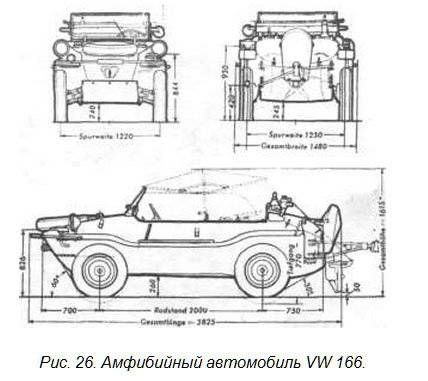
The most common model of this small amphibious vehicle was the VW 166. Its total gross weight was equal to 1345 kilograms, carrying capacity - 435 kilograms. Wheel formula - 4x4. The carburetor engine with a power of 18,4 kW (speed 3000 rpm) had a rear location.
Engine power was removed from the two ends of its crankshaft. From one end to lead to all driving wheels of a car (through a mechanical transmission). From the toe of the crankshaft, the power was taken through the drive shaft with the coupling and the vertical three-row chain drive to the three-bladed propeller lowered to the working lower position. In the working position, almost the entire area of the propeller (diameter 330 mm) was below the plane of the bottom of the car, the protective crutch of the screw - in 50 millimeters from the ground surface.
On the one hand, such an arrangement of the screw practically did not increase the water resistance due to its operation, did not screen the water leakage by the casing and, therefore, increased the efficiency. and traction characteristics of the screw during its operation behind the hull. On the other hand, such an arrangement significantly increased the likelihood of damage to the propeller while driving in shallow water, during entry and exit into and out of water.
Therefore, to prevent screw breakage in contact with underwater primer, its block was carried out flip-up in a vertical plane. When this occurred, the cam clutch disconnected and the engine power supply was automatically stopped. After the protective crutch had gone off the underwater obstacle, the propeller unit was lowered into working position by its own weight, and the driven part of the cam clutch was locked with the leading part of the coupling by the force of the thrust screw. The leading part of the coupling was mounted on the drive shaft. The rotation of the propeller blades occurred inside the protective ring. In the upper part of the protective ring there was a protective visor, which prevented suction to the blades of the propeller of atmospheric air to prevent the fall of thrust. The entire unit of the propeller during movement on land rose to the upper position and stuck on the hull.
The casing was a rational design. The hull was made of 1 mm steel sheets. However, its disadvantages include a large number of seals on the surface and underwater parts of the hull, which, when worn, led to the ingress of seawater into the hull. Another feature of the hull was the absence of wheeled niches shielding the upper part of the wheels and slightly increasing the reserve buoyancy of the car.
The car had an independent suspension of all wheels with their swing in the longitudinal plane. Tire size - 5,25x16. Torsions served as elastic suspension elements. Rear wheel track - 1230 millimeters, front - 1220 millimeters. Overall dimensions: length - 3825 millimeters, width - 1480 millimeters, height with an installed awning - 1615 millimeters. Ground clearance: under the rear axle - 245 millimeters, under the front axle - 240 millimeters, under the bottom - 260 millimeters.
The maximum speed on the highway - 80 kilometers per hour (power density - 13,68 kW / t, fuel consumption - 8,5 liters per 100 kilometers). Maximum speed on calm deep water - 10 kilometers per hour. Froude number by displacement - 0,84.
The main structural disadvantage of this vehicle, as well as of the Triplepel cars, was the inability to simultaneously use the work of the driving wheels and propellers during entering, leaving and swimming in shallow water. This significantly reduced the permeability in these conditions.
In the 1960-1964 years in the Strait of Messina for promotional purposes were demonstrated experienced models of Volkswagen cars with a closed body.
Later, in Germany, Amphi-Ranger 2800SR passenger car was created with the following technical characteristics: wheel formula - 4x4, weight - 2800 kilogram, load capacity - 860 kilogram, engine power 74 or 99 kW and, specific power 26,4 or 35,35 kW / t. Dimensions: length - 4651 millimeter, width - 1880 millimeters, base - 2500 millimeters.
The body of the car was made of 3-millimeter aluminum sheets, designed for 6 people. The shape of the bow is spoon-shaped, the bottom is smooth. In the stern of the hull there was a niche into which the propeller was retracted while on land.
A car with an 74 kW engine developed a maximum speed of 120 km / h (on the highway), and 15 km / h (on water). Froude number by displacement - 1,12. The maximum speed of the car with the 99 kW engine installed was 140 km / h on the highway and 17 km / h on the water. Freeboard is about 500 millimeters. The circulation radius (when turning on the wheels and turning off the propeller) does not exceed 5 meters. The car could be operated on water at wave heights up to 2 meters, when installing a protective awning. On the water control was carried out using the front steering wheels.
Of the other samples that were developed at the end of 60-ies and put on a series, it is necessary to note the ferry-bridge car M2, which had five modifications. Production was organized at the Klockner-Humboldt-Deutz and Eisenwerke Kaiserslautern factories. The machine is used in the German, British and Singapore armies.
The constructions of the ferry-bridge amphibious vehicles of the armies of many countries, including Germany, make it possible to change the way vehicles are transported depending on the conditions. In some cases, automobiles are used as single or modular ferries that have an increased carrying capacity, in others, their design allows direct bridges of various lengths and capacities with double-track or single-track traffic of vehicles forwarded. To do this, two additional metal rigid pontoons are installed on the roof of the vehicle's hull, which, using a hydraulic system, are lowered near the hull on both sides before entering the water, turning at 180 degrees on the lower side hinges. At the bow of the pontoons is mounted on one 600 millimeter propeller. The third millimeter 650 propeller screw is installed in the recess of the bow of the hull under the cab of the main machine. The screw is able to climb into and out of a niche, as well as rotate in a horizontal plane.
As the car was moving afloat stern ahead, an additional control post was set up above the cabin, from which the crew could perform preparatory and basic work on using the car as a ferry-bridge vehicle. In the aft parts of the hull and additional pontoons (during movement on the water, they were nasal), the light-reflecting shields were installed, which prevent the retention of a retaining nasal wave on the body of the machine and the pontoons. To remove seawater in the case of the main machine, several water-draining pumps with electric drives were installed.
In order to facilitate work with additional pontoons during their raising and lowering, as well as for loading and unloading operations with small non-self-propelled cargoes, a low-capacity crane was installed in the transport position along the longitudinal axis of the vehicle.
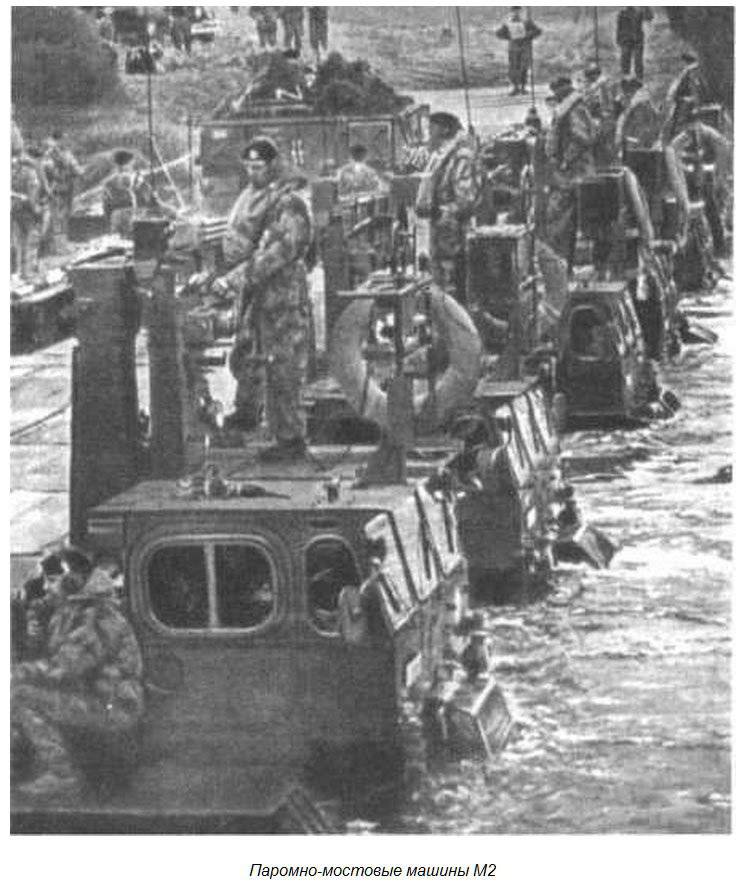
The wheel formula of the ferry-bridge car M2 - 4x4. All steering wheels are equipped with independent suspension. Tire size - 16.00x20.
The car was equipped with two diesel V-shaped 8-mi cylinder engines Deutz Model F8L714 (power of each 131,0 kW, maximum rotation speed 2300 rpm). The specific power of the machine when driving over land without load - 5,95 kW / t.
Net weight of the car 22 thousand kg. Overall dimensions when driving overland in the transport position: length - 11315 millimeters, width - 3579 millimeters, height - 3579 millimeters. Base machine - 5350 millimeters, rear wheel track - 2161 millimeters, front - 2130 millimeters. Ground clearance - adjustable, from 600 to 840 millimeters. The width of the machine when deployed ramps and lowered additional pontoons - 14160 millimeters.
The maximum speed on the highway - 60 km / h, the range of fuel - 1 thousand. Km. The turning diameter is 25,4 m, the relative turning diameter, that is, the diameter related to the length of the car is 2,24.
Movement through the water was ensured by the operation of two 600-millimeter propellers with power supply from one of the engines (the conditional power load of the propeller is 231,4 kW / m2). The other engine rotates the 650 millimeter propeller used to control the car afloat (its conventional energy load is 394 kW / m2). In addition, side propellers were used for afloat control.
The speed of the car on the water up to 14 km / h, the range of fuel - up to 6 hours (Froude number by displacement - 0,74).
The experience of using the ferry-bridge machines M2 made it possible to outline the main directions for modifying its structure. On the new model machine M2D, it was planned to install onboard soft inflatable tanks that made it possible to increase the payload to 70 tons. On the next model - MZ - the direction of movement on water and land was the same (in the M2, movement on the water was stern ahead). In the wheel arches to increase the displacement placed inflatable tanks. In addition, four spans removable structures were replaced by three while simultaneously increasing the dimensions of the link in the bridge line.
It should be noted that at the beginning of 70-s, some German firms began to develop military amphibious vehicles together with companies from other countries. This approach was convenient for many reasons, the most important of which was the legalization of work to bypass the remaining post-war restrictions on the creation of military equipment.
For example, the German company MAN and the Belgian company BN developed the SIBMAS armored car. It was mainly exported to Latin America and Southeast Asia. On the armored car can be installed turret, which has different sets of weapons.
The first sample was made in 1976 year. Total combat weight - 18,5 thous. Kg. The wheel formula is 6x6. Dimensions: length - 7320 mm, width - 2500 mm, height over the roof - 2240 mm, ground clearance - 400 mm.
For the manufacture of the car body, steel armor plates were used, which provided protection against bullets of caliber 7,62 mm.
Department of management was located in the front, with the place of the driver, his controls and surveillance devices are located on the longitudinal axis of the car.
For the department of management housed the space commander and gunner. The variant of an armored personnel carrier could take an 11-13 person to the landing party.
In the rear left of the case is the engine compartment. The engine is a six-cylinder diesel liquid-cooled power 235,5 kW (D2566MTFG company MAN). The power density of the machine is equal to 12,73 kW / t.
Transmission - 6-ti speed automatic transmission type ZF. Suspension - independent.
Movement through the water is provided either by rotation of all the wheels, or with the help of two propellers mounted outside the hull behind the wheels of the third axis in the stern. Speed in deep calm water - up to 10 km / h (Froude number by displacement - 0,546).
Driving speed over land - up to 120 km / h. The 425-liter fuel tank was provided with a power reserve of 1000 km.
The firms Rheinmetall and Krauss-Maffei together with FMC (USA) At the end of the 70 and the beginning of the 80-s, they developed a multipurpose floating self-propelled artillery gun having an 105-millimeter cannon-howitzer. The base served as an American floating armored personnel carrier МХNUMXА113 having a bulletproof booking.
The combat weight of the machine - 14 th. Kg. Crew - 7 man. Machine dimensions: length - 4863 millimeters, width - 2686 millimeters, height - 1828 millimeters, ground clearance - 432 millimeters.
Armament machines were 105-millimeter gun-howitzer (ammunition for 45 shots), 12,7-mm machine gun (ammunition for 4000 cartridges).
The Detroit diesel engine of 221 kW with liquid cooling and turbocharging provided the unit with specific power 15,8 kW / t. This power unit allows you to reach maximum speed - 61 km / h (on the highway) and 63 km / h (on water). The water movement was carried out due to the rotation of the tracks, the upper branch of which was placed in the hydrodynamic casing. Froude number by displacement - 0,36.
In 1973, the Bundeswehr adopted the military reconnaissance amphibious vehicle "Lux" with the wheel formula 8x8. In the middle of 1978, the supply of 408 BRMs ordered by the Bundeswehr was completed. The development of "Lux" began on a competitive basis around the year 1965. It was attended by the company Daimler-Benz, leading the independent development of this machine for those. the task of the Ministry of Defense of Germany, and the joint group of well-known auto companies (Klokner-Humbolt-Dutz, Büssing, MAN, Krupp and Reinstal-Henschel), which created a general design bureau specifically for the creation of this machine.
In the year 1967 conducted initial tests of experimental samples. However, the winner of the competition was not identified. Both cars - and the combined group of companies and the company Daimler-Benz - corresponded to most of the points of the job of the German Defense Ministry. In this regard, both competitors continued to make improvements to the machines, realizing them in the nine subsequent prototypes. The German Defense Ministry at the end of 1973 of the year made its choice and entered into an agreement with the main contractor of the joint group, the company Reinshtal-Henschel.
The first production model "Lux", which was manufactured at a factory in Kassel, in September 1975 was handed over to representatives of the German Bundeswehr.
The features of the overall layout of the "Lux" were two wheelhouse, the wheelbase according to the formula 8x8, all-wheel steering. The main driver who drove the car forward was in front of its body. The second driver, radio operator part-time, was at the second control post in the aft part of the car and is able to move the Lux if necessary, in the opposite direction, without turning the 180 degrees. In this case, the car is able to move in both directions with the same speed.
Since all eight driving wheels of the car are steerable, and the car itself is equipped with two control posts, it is possible to use the steering in three modes: while driving forward, the wheels of two front axles can be used as steering, while the reverse gear - two rear axles. In some cases (maneuvering in cramped conditions at low speeds, driving on soft soils, etc.), all steering wheels were used to change direction. At the same time, the turning radius decreased by almost half, and the permeability on unbound soft soils is improved. The latter can be explained by the fact that the car with such movement formed on the ground only two gauges.
The combat weight of the machine - 19,5 th. Kg. The crew of the car - 4 man. Landing and disembarking of the crew is made through the hatches in the tower and the roof of the hull. In addition, for this purpose a large hatch is made between the wheels of the second and third axles on the left side. Overall dimensions: length - 7740 millimeters, width - 2980 millimeters, height - 2840 millimeters. Ground clearance - 440 millimeters.
Maximum speed - 90 km / h (on the highway). Power reserve - 800 kilometers.
The fully enclosed armored hull protects the crew and equipment from bullets and shell fragments and mines. Frontal projection of the hull provides protection against 20-mm armor-piercing shells.
To increase the secrecy of the movement and the implementation of intelligence, the machine has infrared and sound masking, significantly reduced temperature and noise level of the emitted gases. The use of a perfect noise suppression system makes the car almost inaudible at a distance of 50 meters.
The main armament of the machine is located in a rotating turret having a circular rotation. It was located along the longitudinal axis of the car directly behind the driver's seat. In the double turret (located commander and gunner) installed 20-millimeter unstabilized automatic gun with large elevation angles, which allows you to fire not only at ground, but also at air targets. Ammunition - 400 shells. The rangefinder and periscope sights are installed in the turret, which provide aimed shooting and observation not only during daylight but also at night. In addition, there are 12 prism instruments through which observation is carried out with closed hatches. The MG7,62 3 mm machine gun was an auxiliary weapons and mounted above the commander's hatch. Ammunition machine gun designed for 2000 shots. Six smoke grenade launchers (three on each side) are installed on the sides outside the tower.
As a reconnaissance vehicle, it has modern radio communications and a navigation system.
The engine compartment is located in the middle part and is isolated from the internal volume by special heat and sound insulating partitions. To move from the stern of the machine to the bow there is a passage on the starboard side. In this section, a Daimler-Benz V-shaped X-cylinder multi-fuel diesel engine with turbocharging is installed. Power when using diesel fuel power is 10 kW when using gasoline - 287 kW. Such power provides the vehicle with diesel fuel specific power - 220,8 kW / t, while working on gasoline - 14,7 kW / t. The engine is performed in one unit with a hydraulic transformer, gearbox and other nodes. The main goal of such an installation is to simplify and speed up the replacement of this unit in field conditions during car repairs.
Suspension suspension has elastic spring elements with hydraulic shock absorbers. Tire size - 14.00x20.
A centralized system for regulating tire pressure is connected to all wheels.
The machine has a high permeability, is able to overcome a ditch width up to 190 cm and a vertical wall up to 80 cm, in addition, the machine is able to overcome various water obstacles without preparation.
Movement through the water provide two four-bladed propellers. They are located behind the wheels of the fourth axis outside the armored corps. Propellers can rotate about a vertical axis using a special electro-hydraulic drive. This creates turning points when changing direction, as well as braking afloat.
Maximum speed on the water - 10 km / h. Froude number by displacement - 0,545. To prevent flooding of the upper frontal sheets with a retaining nasal wave and the subsequent increase in the trim of the car, a water-reflecting shield is installed on the top sheet on the nose, equipped with a hydraulic drive.
As noted earlier BRM "Lux" serially produced from 1975 to 1978 year. In other countries, "Lux" was not supplied, but was used as part of the German IFOR contingent in Yugoslavia in NATO and UN operations.
Between the year 1979 and the middle year 1980 began deliveries of the multipurpose floating wheeled armored troop-carrier TPz Fyks with the wheel formula 6х6. They were released around 1000 units.
The development of the armored personnel carrier was carried out from 1973 of the year and Porsche jointly with Daimler-Benz firms, and the production of cooperation was organized in Kassel by several companies headed by Thyssen-Henschel. On the technological basis of this armored carrier, they planned to create seven other modifications: for engineering reconnaissance, command and staff, for chemical and radiation reconnaissance, for electronic warfare, for sanitary services, and others.
The base armored personnel carrier has three sections. Office of Management, in which the place of the driver was located on the left, the seat of the commander of the landing (assistant driver) - on the right. An insulated engine compartment is installed behind the control compartment, to the right of which a passage is made to the amphibious compartment from the control compartment, formed behind the engine compartment up to the rear of the hull. In the troop compartment, facing the board and with their backs to each other, up to the 10 paratroopers are placed on the seats. In the rear hull sheet for landing and landing assault made double door with dimensions of 1250 x1340 millimeters. For landing and landing troops can be used two hatches placed on the roof of the compartment for the landing.
The gross weight of the armored personnel carrier is 16 thous. Kg. Own weight - 13,8 thous. Kg. Load capacity - 2,2 thous. Kg. Dimensions: length - 6830 millimeters, width - 2980 millimeters, height over the roof - 2300 millimeters. Ground clearance under the body - 505 millimeters, under the crankcase axles - 445 millimeters.
The welded body is made of steel armor and provides protection against 7,62-mm bullets from all sides. The frontal projection of the hull is able to protect 300 mm from bullets from a distance of 12,7 meters. Cabin cover glass - bulletproof, can be protected by armor cover.
Armament: 7,62-millimeter machine gun and six smoke grenade launchers located on the left side of the hull. On some machines installed 20-millimeter automatic cannon.
In the engine compartment there is a diesel V-type 8-mi OM 402 A cylinder engine with turbocharging, liquid cooling and servicing systems of Mercedes-Benz. Power - 235 kW, speed - 2500 r / min. The power density of the armored personnel carrier is 14,72 kW / t. The motor is assembled in the same block with the 6-ti 6 HP500 high-speed automatic transmission.
Drive axles have dependent suspension. Driving are the wheels of the two front axles. Tire size - 14.00x20. The turning diameter is 17 meters (on land). Short-term maximum speed - 105 km / h (on the highway), the minimum operating speed - 4 km / h, maximum - 90 km / h. Power reserve - 800 kilometers.
Movement through the water is provided by two 480 millimeter propellers mounted behind the wheels of the third axis outside the hull. Propellers are rotated 360 degrees, regardless of the rotation of the steered wheels using an electro-hydraulic drive to control afloat.
To remove seawater from the hull there are three drainage pumps, the total flow of which is 540 liters per minute. On land, for the discharge of water are used located on the bottom of the hull three valve-Kingston.
Maximum speed - 10 km / h on calm deep water. Froude number by displacement - 0,56.
American specialists from various firms actively participated in the creation of the modified Fuchs BTR. In 1988, for example, the American company General Dynamics and the Thyssen-Henschel firm developed a version of the Fuchs machine for reconnaissance of the terrain after using weapons of mass destruction. It was assumed that if the tests of this car are successful, the United States Army will acquire about 400 units. In 1989, several such vehicles were comparatively tested in various ranges in the United States.
In connection with the preparation by the United States and Great Britain of military operations in the Persian Gulf zone, the country rented 70 Fuchs vehicles. In a very short time, the machines installed special equipment, as they feared the use of chemical weapons by the Iraqi army. In the United States Army, in the beginning of 1993, the first group of specialized XBC93 "Fuchs" NBC vehicles was transferred to field tests. The special equipment installed on them was practically all American. Among the equipment: chemical intelligence sensors, meteorological sensors, a mass spectrometer and other sensors that were installed in the middle part of the body on a retractable mast. At the rear of the car was installed equipment for sampling soil.
On the basis of the Tpz-1 "Fuchs" and other armored wheeled vehicles of the company Mercedes-Benz and EVK started by order of the Bundeswehr in 1978, work on the creation of an armored amphibious ARE (Amphibische Pionier-erkundungs - Kfz-APE), designed for engineering reconnaissance, including on water barriers. This car differs from the base armored personnel carrier, first of all, by the wheel formula 4x4 instead of 6x6 and a set of specials placed in the body. instrumentation.
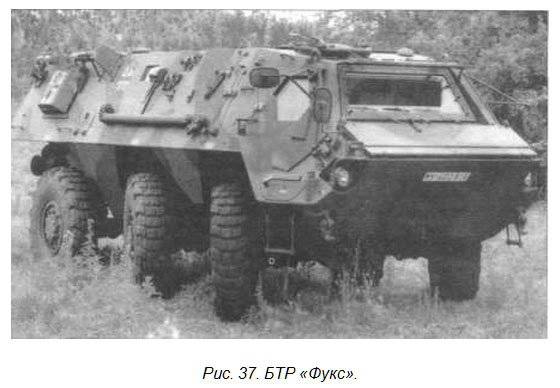
The total combat weight of the vehicle is 14,5 thousand kg. Overall dimensions: length - 6930 millimeters, width - 3080 millimeters, height - 2400 millimeters. Crew - 4 person.
The 235,5 kW diesel engine provides the machine with a high power density (16,0 kW / t), increasing its mobility on the ground and throughput. Wide-profile tubeless tires 20,5х25 also contribute to the improvement of the machine’s passability. In addition, all tires are connected to a centralized air pressure control system. The machine is able to overcome rises up to 35 degrees, a vertical wall up to 50 height, cm, ditches and ditches up to 1 meters wide. The maximum speed on the highway - 80 kilometers per hour while the range of fuel is 800 kilometers.
Armament machine - 20-millimeter automatic cannon, which is installed on the roof of a fully enclosed displacement hull. For the manufacture of hull used sheets of armor steel, which provides bulletproof protection equipment and crew. The machine is equipped with special equipment that allows you to measure the depth, width and speed of the flow of water areas, as well as the steepness of the river banks and the characteristics of the soil surfaces of their channels. In addition, this equipment allows the topographical binding of Kfz-APE on the ground. The machine is equipped with modern means of communication, fire protection system, filtering unit, several smoke grenade launchers placed on its sides outside the hull, and drainage pumps that remove seawater.
The maximum water speed - 12 km / h (Froude number by displacement - 0,68) is provided by two four-bladed rotating propellers with an energy load equal to 892 kW / m2, which are also used for floating control with controlled front wheels.
At the beginning of the 1990-ies, Thyssen-Henschel developed and prepared the serial production of the 4x4 wheeled vehicle of the Condor floating armored personnel carrier, which is intended primarily for import to the countries of South America, Malaysia and others. The design of this machine used a large number of units and units "Unimog" - a car of high traffic.
The bearing displacement hull of the car is made of rolled armor plates, protects at distances more than 500 meters from 12,7-mm bullets, as well as from small fragments of mines and shells. If necessary, a small excess air pressure is created inside the body, which, together with the filtering ventilation system, provides protection from bacteriological and chemical weapons.
In the middle of the hull roof, a single-seat rotating turret was installed, equipped with an 20-millimeter automatic cannon (200 rounds of ammunition) and an 7,62-mm machine gun paired with it (500 rounds of ammunition). On each side of the body installed 4 smoke grenade launcher.
The aft and middle part of the hull is occupied by the troop compartment. For landing and landing assault is used aft door. The driver's seat is in an armored cockpit, which protrudes relative to the upper part of the hull along the port forward. In front of the cabin and on the sides there are windows that are closed with armor covers if necessary. In the roof of the cabin there is a hatch. For the sealed partition to the right of the driver's seat is the engine compartment. It contains a diesel 124 kW 6-cylinder liquid-cooled engine from Daimler-Benz, its systems, as well as some mechanical transmission units. Wheel suspension dependent, front axle wheels - driven.
Crew - 2 person. The landing party is 10 man. Machine weight - 12,4 thous. Kg. Overall dimensions: length - 6500 millimeters, width - 2470 millimeters, height - 2080 millimeters. Ground clearance - 480 millimeters. Maximum speeds: 105 km / h (on the highway), 10 km / h (on the water). Cruising on roads for fuel - 900 kilometers.
In Germany, as in other countries, in addition to heavy, medium and light amphibious vehicles, small-sized amphibious conveyors were built and tested for the transport of small consignments of various purposes and types in a wide range of traffic conditions. These machines were used mainly on dirt surfaces with relatively low coupling and carrying parameters.
From this group of machines, it is necessary to take as an example three amphibious small-sized conveyors - Solo 750, Chico and Allmobil Max 11. Allmobil Max 11 was developed in collaboration with the United States.
This type of conveyor is characterized by open bearing bodies made of reinforced plastics, fixed wheels not attached to the body, simplified designs of the running gear and transmissions.
Amphibious conveyor Solo 750 (wheel formula 6x6) has a displacement bearing body made of reinforced plastic composition. Wall thickness - 5 millimeters. In the most loaded places, the walls are reinforced with metal inserts.
Own weight Solo 750 - up to 220 kilogram, carrying capacity - 230 kilogram, gross weight - 450 kilogram. Overall dimensions: length - 2130 millimeters, width - 1420 millimeters, height - 960 millimeters (without awning).
The installation of 15,2 kW 2-x stroke 2-x cylinder diesel engine or 2-x cylinder gasoline engine 18,4 kW with an opposite arrangement of cylinders (rotational speed 6000 r / min) is provided. Specific power when using a gasoline engine is 40,88 kW / t.
From the engine torque is transmitted to the middle wheels, followed by chain drives to the rear and front wheels. Transmission (reverse, infinitely variable) allows you to move at a speed of - 60 kilometers per hour. Cruising range for fuel - 120 kilometers.
Changing the direction of movement is carried out by braking the wheels on one side. Management was carried out by special levers. At the same time, a double differential with two controlled friction elements ensures smooth control of the turning radius, but no linear stable movement is achieved on dirt surfaces that have different resistance to movement along the sides.
Belt brake mechanisms are also controlled by levers. When you press the foot pedal, the front wheels are braked, the other wheels - through chain transmissions.
When rigid wheels are mounted to the body, smoothness is ensured thanks to low-profile wide-profile tubeless tires. Wheel ground pressure is up to 35 kPa.
The speed of movement on the water reaches 5 kilometers per hour. The movement is carried out by rotation of wheels. At the same time, the Froude number by displacement is 0,5. When installing an outboard motor, the speed of movement in deep calm water increases to 9 km / h, while the Froude number increases to equal 0,91.
Another amphibious compact conveyor Chico was a less successful model because it had the wheel formula 4x2, the total weight of 2400 kilograms and the carrying capacity of 1000 kilograms. Overall dimensions: length - 3750 millimeters, width - 1620 millimeters, height - 1850 millimeters. The conveyor has a mechanical transmission. As in other models, the propulsion wheel are wheels. On land, the maximum speed is up to 65 km / h. At the same time, the speed on the water is not very high, since the thrust force is created only by two wheels.
The Allmobil Max 11 transporter was designed as an amphibious vehicle for service and personal use. This machine was developed by the German company Allmobil together with the American company Recreatives Industries Ing. In 1966, small-scale production was started.
The wheel formula of the conveyor - 6x6, gross weight - 600 kilogram, carrying capacity - 350 kilogram. Overall dimensions: length - 2320 millimeters, width - 1400 millimeters, height - 800 millimeters, ground clearance - 150 millimeters, gauge - 1400 millimeters. The engine power placed in the hull behind the passenger and driver's aft seats is 13,3 kW or 18,4 kW. The power density of the conveyor 22,2 or 30,7 kW / t, respectively. The engine provides with a maximum speed of up to 50 km / h.
Bearing machine body is made of plastic. In places subject to the greatest loads strengthened. All conveyor wheels equipped with low-profile wide tires are rigidly attached to the body. Wheel ground pressure is from 20 to 30 kPa. The machine has a continuously variable transmission with chain drive all wheels. In addition, it is possible to install a transmission with a centrifugal clutch and 5-speed manual transmission.
Tape-operated brake mechanisms with lever control are used for braking or changing the direction of movement on water and on land due to the complete stop or braking of wheels on one side of the machine.
Movement through the water provides all-wheel drive, while the maximum speed is 5 km / h (Froude number in displacement - 0,48).
A transporter may have four or two seats. Electrical equipment includes Allmobil Max 11 necessary lighting and signaling devices that provide the vehicle with the status of a road vehicle.
In 1982, the floating EWK Bizon truck, designed for use in various civilian areas, was first introduced at an aviation exhibition in Hanover. The wheel formula of a two-axle vehicle is 4x4, a control cabin on a 2-3 person.
Vehicle weight - 11 thousand kg, weight with cargo - 16 thousand kg. Lifting capacity on water and on land is 5 thous. Kg, but in some cases it can increase to 7 thous. Kg. Overall dimensions: length - 9340 millimeters, width - 2480 millimeters, height - 2960 millimeters (on the cab), and 3400 millimeters (on the awning). Specific power - 14,7 kW / t. Maximum travel speed - 80 km / h. Cruising on fuel 900 km.
The V-shaped, 8-cylinder, diesel engine air-cooled, whose power is 235,5 kW, is arranged behind the control cabin above the front axle. Cargo platform is located behind the engine compartment. Cabin doors and platform flaps are located above the waterline.
Movement through the water ensures the operation of two full-turn screws, which are installed in the aft part. A change in the position of the propellers relative to the longitudinal axis of the amphibious truck ensures good control afloat, however, there is a slight decrease in the speed of movement on the circulation. To reduce water resistance, which increases the speed of movement through the water, the machine has a wheel lifting system. The maximum speed is 12 km / h and the power reserve is 80 km. Froude number by displacement - 0,67.
On the basis of Bizon created a variant ALF-2. On its cargo platform there are two hydrants and additional equipment. Hydrant water supply - 4000 liters per minute. The total weight of the ALF-2 is 17 thousand kg.
At about the same time, another transport floating vehicle, the Amphitruck AT-400, was developed for raid unloading of ships. This car looks similar to Bizon. Cargo platform allows to place 20-ton containers with dimensions 6000x2400x2400, see. Overall dimensions of the car allow its transfer by air or rail.
The wheel formula is 4x4. Vehicle weight with load - 43 thous. Kg.
Diesel engine power equal to 300 kW (power density - 6,98 kW / t) allows you to reach the speed of 40 km / h (on the highway). Cruising range - 300 km.
Overall dimensions: length - 12700 millimeters, width - 3500 millimeters, height at the cabin - 4000 millimeters. Cargo compartment dimensions: width - 2500 millimeters, length - 6300 millimeters.
All car wheels are driven.
The maximum speed of movement on deep calm water does not exceed 10 kilometers per hour, while the Froude number in displacement (or relative speed) is 0,475. Cruising on water for fuel up to 80 kilometers.
This article provides descriptions of not all amphibious vehicles developed in the 20th century in Germany. However, the main approaches to the creation of such machines and those achieved. characteristics reviewed. At the same time, these materials show that German design bureaus and industrial enterprises in the last century managed to accumulate quite a lot of experience in creating amphibious tracked and wheeled vehicles of various purposes and designs. whose characteristics have improved.
Based on the article "Amphibious Machines of Germany" Alexey Stepanov, the magazine "Equipment and Armament yesterday, today, tomorrow ...", 2002
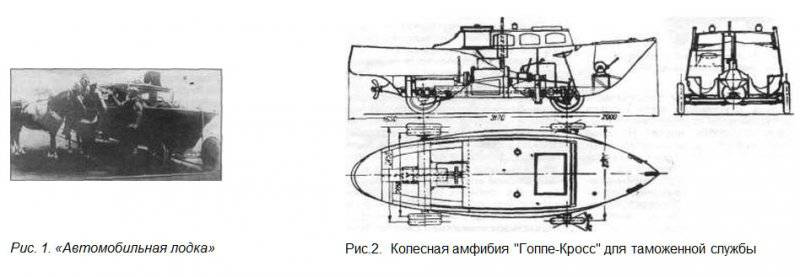
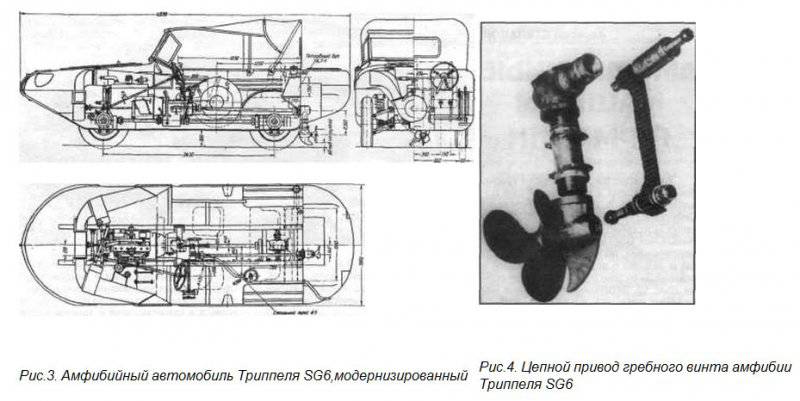
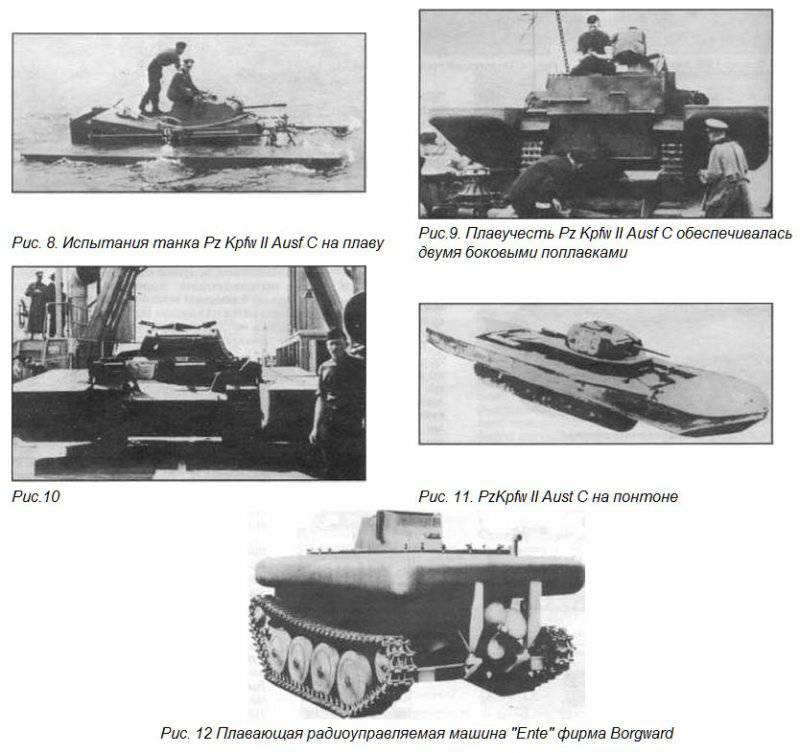
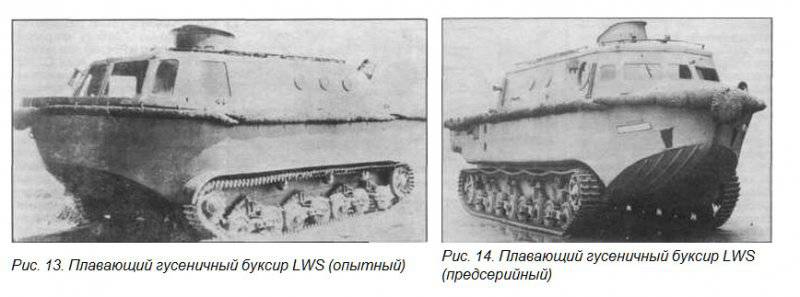
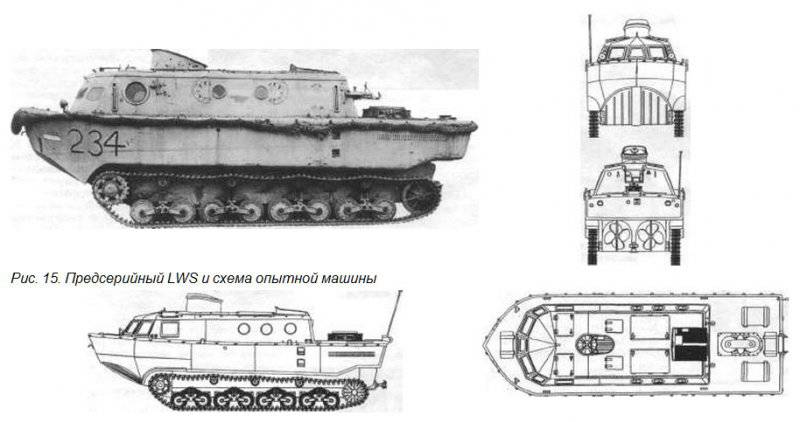


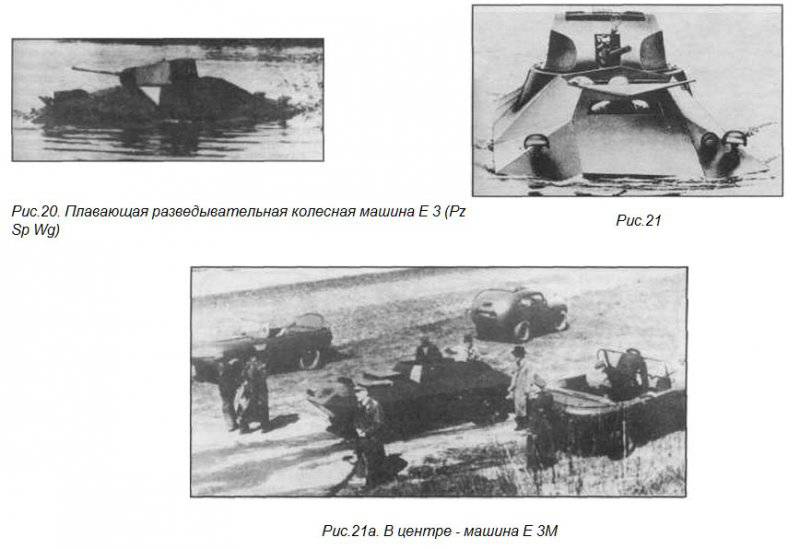
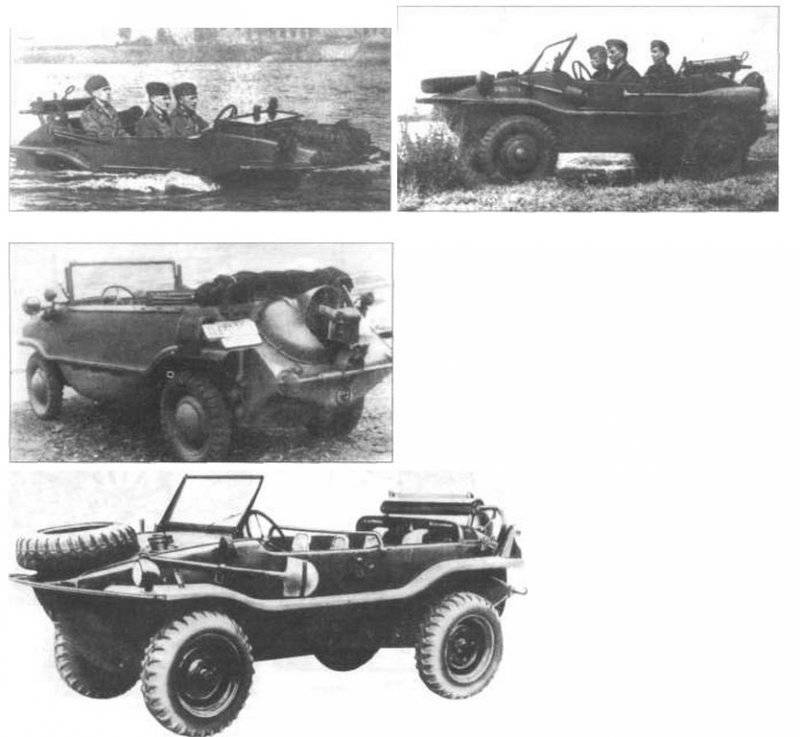
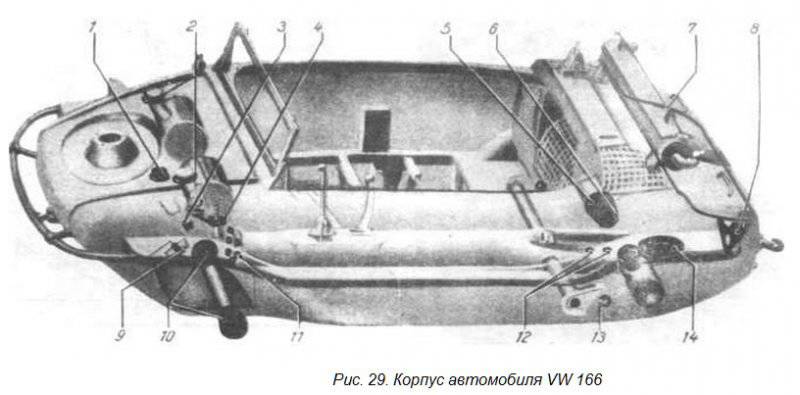

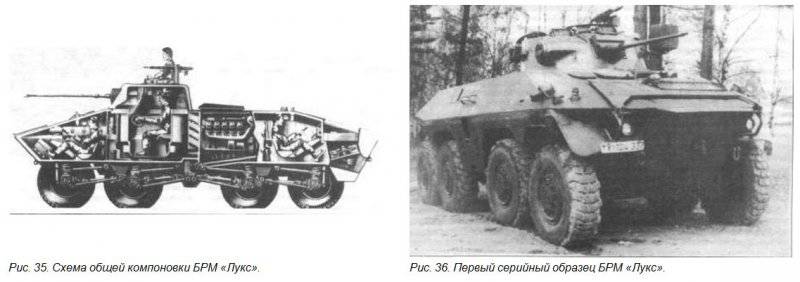
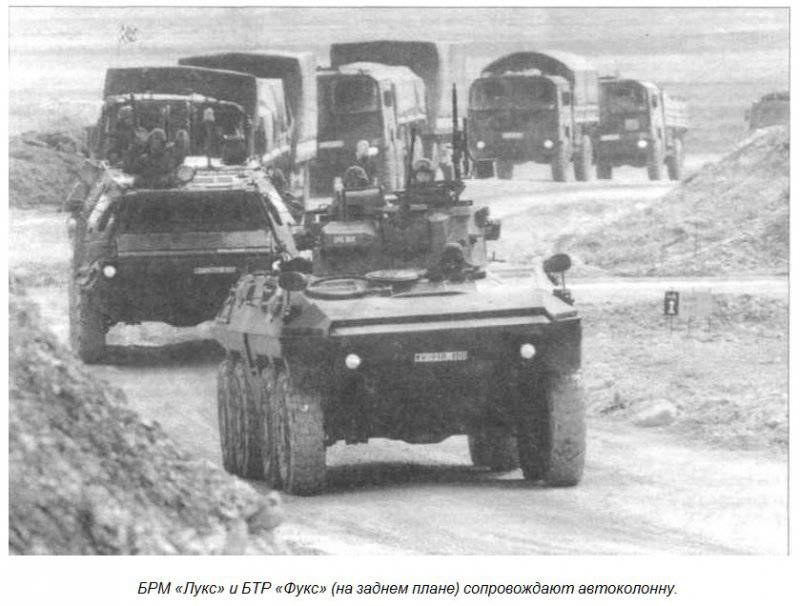
Information